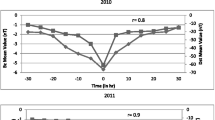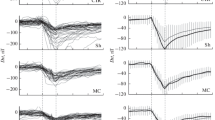Abstract
The aim of this paper is to investigate the association of the geomagnetic storms with the magnitude of interplanetary magnetic field IMF (B), solar wind speed (V), product of IMF and wind speed (\(V \cdot B)\), Ap index and solar wind plasma density (\(n_{\mathrm{p}})\) for solar cycles 23 and 24. A Chree analysis by the superposed epoch method has been done for the study. The results of the present analysis showed that \(V \cdot B\) is more geoeffective when compared to V or B alone. Further the high and equal anti-correlation coefficient is found between Dst and Ap index (− 0.7) for both the solar cycles. We have also discussed the relationship between solar wind plasma density (\(n_{\mathrm{p}})\) and Dst and found that both these parameters are weakly correlated with each other. We have found that the occurrence of geomagnetic storms happens on the same day when IMF, V, Ap and \(V \cdot B\) reach their maximum value while 1 day time lag is noticed in case of solar wind plasma density with few exceptions. The study of geomagnetic storms with various solar-interplanetary parameters is useful for the study of space weather phenomenon.
Similar content being viewed by others
Avoid common mistakes on your manuscript.
1 Introduction
A geomagnetic storm is a disturbance of the Earth’s magnetic field (Akasofu & Chapman 1963) that arises due to the perturbations in the interplanetary magnetic field (IMF) and the solar wind. These perturbations are responsible for the sudden commencement in geomagnetic activities. A variety of geomagnetic storms and their manifestations have been discussed by many authors (Tsurutani et al. 1988; Oh & Yi 2004; Kane 2014; Singh & Mishra 2015). Gonzalez et al. (1994) and Bakare & Chukwuma (2010) explained that the geomagnetic storms play extensive role in space weather scenario by transfer of enhanced energy from the solar wind/IMF to the magnetosphere which results in the increment of charged particles in ring current. Murayama (1982) and Gosling (1993) observed that perturbations in the IMF play a key role in producing geomagnetic storms (GS) and suggested that southward oriented interplanetary magnetic field (IMF) is more geoeffective as compared to the north one. The occurrence of GS depends on various solar interplanetary parameters such as solar wind, magnetic clouds, coronal mass ejections (CMEs) etc., so we cannot state that any single parameter alone is responsible for the occurrence of geomagnetic storms.
(a) The result of Chree analysis from \(-\,6\) days to \(+\,6\) days with respect to zero epoch day (occurrence day of GS). The variation of mean values of magnitude of IMF vector (nT), Dst (nT) and Ap index (nT) is plotted to depict the observational trend of two parameters for the respective years on a day-to-day basis for solar cycle 24. (b) The result of Chree analysis from \(-\,6\) days to \(+\,6\) days with respect to zero epoch day (occurrence day of GS). The variation of mean values of magnitude of IMF vector (nT), Dst (nT) and Ap index (nT) is plotted to depict the observational trend of two parameters for the respective years on a day-to-day basis for solar cycle 23.
Solar wind can be described as the flow of charge particles originating from the upper atmosphere of the Sun. The solar wind generally alter its speed, density and temperature with time and longitude. Because of coronal heating, the solar wind particles attain escape velocity and it expands away from the Sun and when these solar winds with their high speed enter the interplanetary medium they can also disturb the Earth’s magnetic field (Cane & Richardson 1995; Loewe & Prolss 1997). Kane (2005) and Sabbah (2001) established a relationship between V and Dst for the period 1965–2003. They also found that geomagnetic storms mainly occur when the IMF interacting with the Earth has a strong southward Bz component. Furthermore, their studies showed that the product of interplanetary magnetic field and wind speed is more compelling to the geomagnetic storms than the other interplanetary parameters.
Crooker et al. (1977) additionally showed that the association between geomagnetic indices with the product \(V \cdot B\) is very high and striking. The relationship between geomagnetic activities with respect to Dst are also discussed in detail by Jurac & Richardson (2001), Rathore et al. (2014) and Dan et al. (2014). Bieber et al. (1993) reported the existence of a linear relationship between B and Ap index for solar cycles 21 and 22.
2 Data analysis and method
A Chree analysis technique by the superposed epoch method has been used for the present study with the occurrence day of geomagnetic storms (criteria Dst \(\le -50\,\hbox {nT}\)) as zero day. The daily mean values of the Dst index, IMF, Ap index, solar wind speed and plasma density are taken from the omniweb data center (omniweb.gsfc.nasa.gov/form/dx1.html) for the studied period of the solar cycle 23 (1996–2006) and the solar cycle 24 (2009–2017). We have also calculated the correlation coefficient between these parameters (Dst index, Ap index, IMF(B), solar wind speed (V), \(V \cdot B\), plasma density). We used unbinned data for our study with a time resolution of one day. Now, by taking Dst \({\le }-50\,\hbox {nT}\) as zero day,we have considered the six values above it as \(-1, -2, -3, -4, -5, -6\) days and six values below it as \(+1, +2, +3, +4, +5, +6\) days. Further, all the daily observations have been averaged and a graph has been plotted to depict the observational trend of two parameters for the respective years on a day-to-day basis. We have also calculated the average correlation coefficient for the respective years between various solar and interplanetary parameters with the help of cross correlation analysis.
3 Results and discussion
3.1 IMF, Dst index and Ap index
The interplanetary magnetic field is a part of the Sun’s magnetic field that is carried into interplanetary space by the solar wind. Figures 1(a), (b) are focused on comparing Dst with IMF and Ap index. We have compared the profiles of Dst, IMF and Ap index for both the solar cycles 23 and 24 and inferred that these parameters are highly anti correlated with each other for both the solar cycles. We found that the strongest increment in IMF and Ap index occurs on the same day when Dst achieves its minima without any time lag while a finite time lag of 3 h was noticed by Saba & Gonzalez (1997). The difference in the time resolution could be the possible explanation for this kind of discrepancy, and in addition to this, the existence of time lag can give us an idea of the mechanism operating in the energy transfer. Even the peaks of Ap index are found to be more sharp when compared to IMF crests on zero day (0 day). Further the correlation coefficient of Dst with Ap index for solar cycle 23 (\(-\,0.7\)) and solar cycle 24 (\(-\,0.7\)) is found to be the same and is high, which clearly exhibits that Ap index is a geoeffective parameter. On comparing the correlation coefficient of Dst and IMF, we have found that solar cycle 23 (\(-\,0.7\)) possesses high correlation coefficient when compared to solar cycle 24 (\(-\,0.6\)). Our results are in good agreement with the findings of Tiwari et al. (2011) and Rathore et al. (2014) that IMF is a geoeffective parameter. We have also calculated the correlation coefficient of Dst vs. solar wind speed for both the solar cycles and found that this correlation is weak in case of solar cycle 23 (\(-\,0.7\)) as compared to solar cycle 24 (\(-\,0.6\)) (Table 1).
(a) The result of Chree analysis from \(-\,6\) days to \(+\,6\) days with respect to zero epoch day (occurrence day of GS). The variation of mean values of Dst and \(V \cdot B\) is plotted to depict the observational trend of two parameters for the respective years on a day-to-day basis for solar cycle 24. (b) The result of Chree analysis from \(-\,6\) days to \(+\,6\) days with respect to zero epoch day (occurrence day of GS). The variation of mean values of Dst and \(V \cdot B\) is plotted to depict the observational trend of two parameters for the respective years on a day-to-day basis for solar cycle 23.

(a) The result of Chree analysis from \(-\,6\) days to \(+\,6\) days with respect to zero epoch day (occurrence day of GS). The variation of mean values of Dst and plasma density (\(n_{\mathrm{p}})\) is plotted to depict the observational trend of two parameters for the respective years on a day-to-day basis for solar cycle 24. (b) The result of Chree analysis from \(-\,6\) days to \(+\,6\) days with respect to zero epoch day (occurrence day of GS). The variation of mean values of Dst and plasma density (\(n_{\mathrm{p}})\) is plotted to depict the observational trend of two parameters for the respective years on a day-to-day basis for solar cycle 23.

3.2 Dst index and \(V \cdot B\)
After investigating the connection of Dst with V and B independently we have examined in Fig. 2(a), (b) how Dst index varies with the product of IMF and solar wind speed (\(V \cdot B)\). We came to an interesting conclusion that for both the solar cycles, Dst is highly anti correlated with \(V \cdot B\) when contrasted with V or B alone. The analysis of Fig. 2(a), (b) clearly demonstrates the inverse alliance between Dst and \(V \cdot B\) which indicates that the strongest increment in \(V \cdot B\) happens on the occurrence day of GS (i.e. on 0 day). The average correlation coefficient between these two parameters is observed to be high for the solar cycle 23 (\(-\,0.8\)) as compared to solar cycle 24 (\(-\,0.7\)). This kind of high anti correlation coefficient favors the prior findings of Wang et al. (2003) and Dwivedi et al. (2009) that \(V \cdot B\) is the more effective parameter for generating GS in comparison to V or B alone.
3.3 Dst and solar wind plasma density
We have additionally compared the profiles of Dst index with solar wind proton density and reached to the conclusion that the strongest increment in plasma density takes place one day before the occurrence day of GS, i.e. there exist a time lag of 1 day between the occurrence day of GS and maximum peak of plasma density (\(n_{\mathrm{p}})\) except for the year 2009 and 2014. Similar sort of 1 day time lag is also observed for solar cycle 23 with the exception for the year 1996. The correlation coefficient between Dst index and solar wind proton density was found to be weak for both the solar cycles which clearly indicates that proton density is not a geoeffective parameter which shore up the earlier findings of Kharayat & Prasad (2017) (Fig. 3).
4 Conclusions
From the present study, we have concluded that
-
(1)
Dst is highly anti-correlated with IMF and Ap index.
-
(2)
The correlation coefficient of Dst with Ap index for solar cycle 23 (\(-\,0.7\)) and solar cycle 24 (\(-\,0.7\)) is found to be the same and is high which clearly exhibits that Ap index is a geoeffective parameter.
-
(3)
The correlation coefficient of Dst and IMF is found to be high for solar cycle 23 (\(-\,0.7\)) as compared to solar cycle 24 (\(-\,0.6\)).
-
(4)
Dst is highly anti correlated with \(V \cdot B\) when contrasted with V or B alone.
-
(5)
The existence of 1 day time lag is noticed between the occurrence day of GS and the maximum peak of plasma density except for the year 2009, 2014 (solar cycle 24) and 1996, 2003 and 2004 (solar cycle 23).
-
(6)
The correlation coefficient between Dst index and solar wind proton density was found to be weak for both the solar cycles which clearly indicates that proton density is not a geoeffective parameter.
References
Akasofu S. I., Chapman S. 1963, Space Sci. Rev., 2, 91
Bakare N. O., Chukwuma V. U. 2010, Indian J. Radio Space Phys., 39, 150
Bieber J. W., Chen J., Mathaeus W. H., Smith C. W., Pomerantz M. A. 1993, J. Geophys. Res., 98, 3585
Cane H. V., Richardson I. G. 1995, J. Geophys. Res., 100, 1755
Crooker N. U., Feynmam J., Gosling J. T. 1977, J. Geophys. Res., 82, 1933
Dan A., Chaudhuri D., Nag A. 2014, Int. J. Innov. Res. Sci. Eng. Technol., 3
Dwivedi V. C., Tiwari D. P., Agarwal S. P. 2009, J. Geophys. Res., 114, A05108
Gosling J. T. 1993, J. Geophys. Res., 98, 937
Gonzalez W. D., Joselyn J. A., Kamide Y., Kroehl H. W., Rostoker G., Tsurutani B. T., Vasyliunas V. M. 1994, J. Geophys. Res., 99, 5771
Jurac S., Richardson J. D. 2001, J. Geophys. Res., 106, 29195
Kane R. P. 2014, Indian J. Radio Space Phys., 43, 151
Kane R. P. 2005, J. Geophys. Res., 110, 2213
Kharayat H., Prasad L. 2017, Astrophys. Space Sci., 20, 362
Loewe C. A., Prolss G. W. 1997, J. Geophys. Res., 102, 14209
Murayama T. 1982, Rev. Geophys. Space Phys., 20, 623
Oh S. Y., Yi Y. 2004, J. Korean Astron. Soc., 37, 151
Rathore B. S., Gupta D. C., Parashar K. K. 2014, Int. J. Geosci., 5, 1602
Saba M. M., Gonzalez W. D. 1997, Ann. Geophys., 15, 1265
Sabbah I. 2001, Proc. 27th Int. Cosmic Ray Conference, p. 3860
Singh S., Mishra A. P. 2015, Indian J. Phys., 89, 1227
Tsurutani B. T., Gonzalez W. D., Tang F., Akasofu S. I., Smith E. 1988, J. Geophys. Res., 93, 13851
Tiwari J., Tiwari A. K., Shrivastava A. 2011, Rom. J. Phys., 56, 801
Wang C. L., Shen C. L., Wang S., Ye P. Z. 2003, Geo. Res. Lett., 30, 2039
Acknowledgements
The authors are thankful to IUCAA, Pune for content page service and are also thankful to ARIES, Nainital for providing library and computing facilities.
Author information
Authors and Affiliations
Corresponding author
Rights and permissions
About this article
Cite this article
Pokharia, M., Prasad, L., Bhoj, C. et al. A comparative study of geomagnetic storms for solar cycles 23 and 24. J Astrophys Astron 39, 53 (2018). https://doi.org/10.1007/s12036-018-9538-1
Received:
Accepted:
Published:
DOI: https://doi.org/10.1007/s12036-018-9538-1








